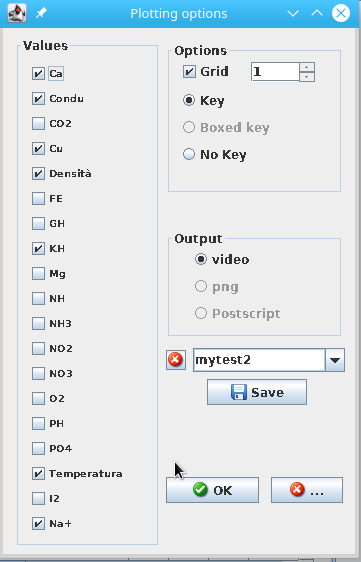

The reading table is used to store the values of aquarium parameters that You can check with test kits (eg. No2, PH) or instruments (eg. Temp, Cond).

Date: The date when the reading has been taken. This is relevant for plotting and to see how thing changes in time.
Time: The hour and minute when reading has been take. It's important because some values (eg. PH) vary during the day.
PH: The measure of the acidity or basicity of aquarium water it's the concentration of dissolved hydronium ions (H3O+). Keep in mind that the unit scale is logaritmic so a value is 10x the previous and 1/10 of next in scale.
In planted aquariums this value changes from morning to evening due to plants 'breathing' (day/night cicle).
NO2: The value of nitrites. Should be 0 after startup period.
NO3: The value of nitrates. Should be 0 in fish only tanks, up to 10 ppm in planted aquariums.
total NH: The value of ammonia (NH3) + Nitrogen (Nh4). Should be 0.
High values of NH, NO2 or NO3 are indicators of inadequate filtration or a non correct tank cleaning.
NH3: The value of ammonia calculated from NH and temperature. An alert is showed for dangerous values.
KH: The carbonate hardness of water. Values under 2ppm should be avoided.
GH: Total hardness of the water. It's given from the sum of CA and MG cations. This value should be adequate to fish species.
Temp: The temperature of water. Some fish requires determinate ranges of values.
CO2: This is the value of CO2 in water (usually in ppm). The value can be derived from PH and KH with the formula pH=7,5+Log(KH)-Log(ppmCO2)
The CO2 button use this formula to keep out any of the values from the other two. In planted aquariums the CO2 value should be approx 20->30 ppm.
An alert is showed for dangerous values.
FE: The quantity of iron in water. The value should be less than 1 mg/l (less for some invertebrates).
CU: The copper in water. This element is toxic also at low levels for many species of invertebrates.
Cond: The conductivity of the water. It depends from ions in water solution. Ordinary distilled water in equilibrium with carbon dioxide of the air has a conductivity of about 10 x 10-6 W-1*m-1 (20 dS/m). Because the electrical current is transported by the ions in solution, the conductivity increases as the concentration of ions increases. Usually this value should be keep low for some fish species.
Dens: Water density. Very used in marine aquarium.
CA: Calcium ions in water. With magnesium gives total GH value
MG: Magnesium ions in water. With calcium gives total GH value.
PO4: Phosphate ions in water.
O2: Free oxygen in water.
I2: Iodine quantity in water.
Na+: Water salinity.
There is a button in this table to get average values and another one to get a graph of the values. These are useful to see how things change in time.
Readings can be plotted into graphs trough the related button:
![]()
When this button is pressed a dialog form is open to allow you to choose what to plot and where to plot it:

In this sample only NO3, PH and temperature readings will be plotted; on video, with background grid (spacing one unit) and a key that explain readings showed...
As you can see you can save your chosen with save button after enteringin the combo box a name for the configuration. Later you cas chose saved configurations.
The result with the values showed above is the following:

As you can see the date are not very readable due to long interval of data sample (over 4 years) but you can easily filter by date with the fields in main window.
A second plot is available trough the 'Plot compatibility chart' button:
![]()

When
this button is pressed a dialog form (similar to the readings plot
one) is opened to allow you to chose what to plot and where to plot.
It's better to explain what we mean with compatibility and what is compatibility chart:
If NO2, NO3, CO2, KH, PH and temperature values goes out of scale they may seriously hurt fish and plants.
While NO2, NO3, CO2, should be ever in fixed ranges the other values tolerance is more species specific. With this chart the values are checked against species to check if any is in danger. If you insert the specie values before to introduce the item in aquarium a preventive compatibility check can be executed.
This check can be done with the last reading take or with medium values or, if you select one, with a specific value in readings table.
In this sample last value of KH, PH and temp are checked against fish and the result will be plotted on video. No grid will be used but labels (key) will be displayed.
The result is the following:

It's easy to see that Neon Tetra requirements of PH (red) and KH (green) are out (lower than) of last value (vertical line). Similar is the PH: to high for Cardinal tetra. It's also possible to see that Angelfish and Amano shrimp can't live together in the same aquarium easily because the lower temperature for Angelfish is near the maximum supported from shrimp.